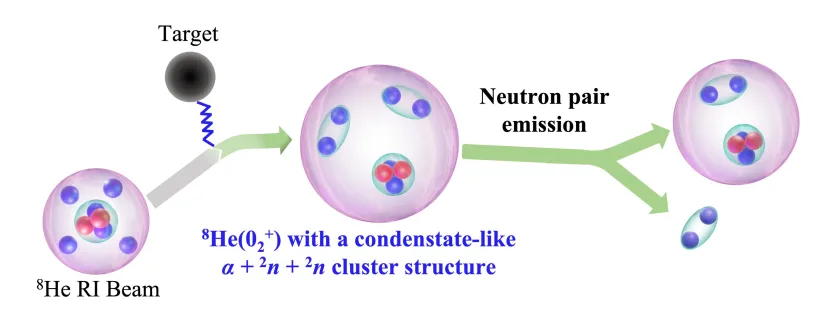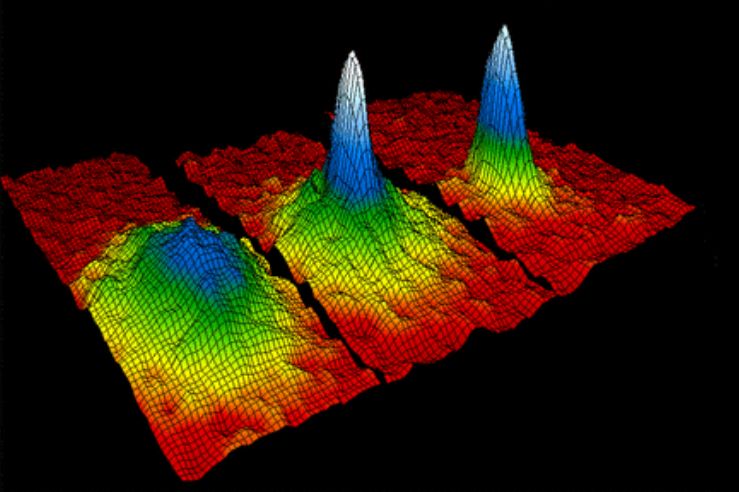
Scientists at Peking University have successfully uncovered the elusive 02+ state of 8He. The 02+ state of 8He refers to a specific energy state of the helium-8 (8He) nucleus.
The “2+” signifies that the state has a positive parity, and the “0” indicates a specific spin value. The observation and understanding of such nuclear states provide valuable insights into the structure and behavior of atomic nuclei.
The researchers have found a funky cluster setup with two neutron pairs; it’s like an unconventional but interesting configuration.
The discovery of exotic nuclear formations isn’t just a one-time thing. It will contribute to our knowledge of unusual arrangements of protons and neutrons within atomic nuclei. And their potential implications for understanding phenomena like neutron stars.
Nuclear Stability in the World of Magic Numbers
In the nuclear world, protons and neutrons are moving independently within the nucleus. There is this very well-defined shell structure, where every entity has a dedicated spot.
It means that the energy associated with the arrangement of nucleons (the subatomic particles) within a nucleus is created by nuclear forces.
At times, these nucleons fill up energy levels or shells, creating some serious stability vibes. In fact, the resulting configurations often lead to more stable nuclei. We call these stable setups “magic numbers”.
The concept of magic numbers and the nuclear shell model provide a framework for understanding the stability of atomic nuclei based on the arrangement of nucleons within them.
Advancing Beyond the Standard Shell Model for Exotic Nuclei
Although, the nuclear shell model rooted in quantum mechanics is a powerful tool for explaining the structure and stability of many atomic nuclei, it faces challenges when dealing with exotic nuclei. Here’s why:
- Exotic nuclei: It may have unusual combinations of protons and neutrons that go beyond the scope of the standard nuclear shell model.
- Neutron-rich nuclei: The behavior of neutron-rich nuclei challenges the simplicity of the shell model.
- Unstable Nature: Exotic nuclei are inherently unstable, so it engages in all sorts of radioactive decay antics. The dynamics of decay processes coupled with the intricate interplay of forces, challenges to the traditional nuclear shell model, which wasn’t initially designed to handle such complexities.
- Beyond Mean Field Approximation: According to the shell model, all nucleons all moving in sync, influenced by an average potential created by all other nucleons. This is called as “Mean Field Approximation”. In exotic nuclei, the deviations from this mean field become more pronounced, requiring more sophisticated theoretical frameworks.
To address these challenges and advance our understanding of exotic nuclei, researchers are exploring advanced theoretical models that go beyond the current challenges.
Decoding Complex Interactions
First author of the study, Prof. Zaihong Yang, explains how the team aims towards decoding the complex nuclear interactions that govern the behavior of each nucleon. And understand the forces at play, along with uncover the patterns that define the nucleus’s structure.
Therefore, the neutron-rich nucleus 8He has stirred up quite a bit of interest, especially because of its intriguing condensate-like cluster structure. This condensate-like cluster structure suggests a distinctive organization, almost like the nucleons are forming clusters akin to a condensed state of matter.
In this special case, two neutron pairs also called as dineutron clusters are teaming up with an alpha cluster, which is basically four helium nuclei hanging out together. The outcome is “condensate-like cluster structure”. Here the researchers are drawing comparisons with Bose-Einstein condensates (BECs).

When theoretical vision meets the real-world experimentation
In Bose-Einstein condensates (BECs), particles like atoms get into the same quantum state. Similarly, in the context of the 8He cluster state, two dineutron clusters and the alpha cluster are teaming up and contributing to the nuclear structure, almost like they’re all vibing in the same quantum state.
To scrutinize and probe the theorized cluster state within 8He, the researchers performed nuclear scattering experiment at the RIKEN Nishina Center in Japan. Their experiment concluded that in the 02+ excited state of 8He, those four valence neutrons are not just casually hanging out – they’re teaming up to form not one, but two super-tight neutron pairs, aka dineutron clusters, explained Prof. Yanlin Ye, second author of the study.
This achievement is a testament to the synergy between theory and experimentation.
Takeaway
Understanding nuclear condensates will surely provide a unique window into the astrophysical processes that shape the elements within helium-burning stars as well as dense astronomical objects with unique properties.
And who knows, it could totally flip our understanding of cosmic alchemy!
Via: Physics Magazine and Phys.org



